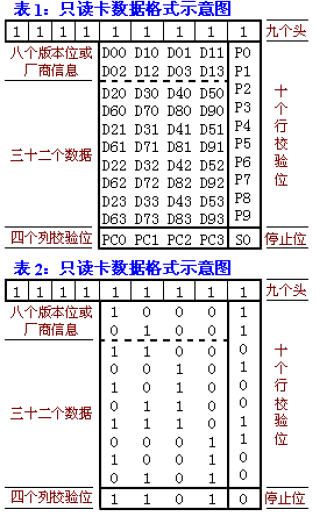Chip description:
The TK4100 is a CMOS integrated circuit microchip that is widely used on RF-sensing cards. The TK4100 chip circuit is powered by an external antenna coil placed on an alternating magnetic field and derives its clock frequency from the magnetic field via one of the coil terminals. The other coil termination is affected by the chip's internal modulator and is converted to a current-mode switch modulation to transmit 64-bit information and commands containing the manufacturer's pre-program arrangement to the reader. The TK4100 is fully compatible with 礒M's EM4100 chip format.
The TK 4100 has some basic options that are used to define code types and data rates. For example, the data rate per bit can be 64, 32, and 16 times the carrier frequency, and the data can be encoded as a Manchester, Biphase, or PSK (Phase Modulation) modulation format. The chip is laser programmed during the polysilicon bonded state to store a unique code on each chip. The continuous output data string contains 9 '1' bits of header, 40 bits of data, 14 bits of parity, and 1 bit of stop bits. Due to the low micro-power consumption of the logic control center, there is no need to provide a snubber capacitor. Only the energy of the chip operation needs to be obtained by an external antenna coil, and a capacitor integrated in parallel with the external coil can obtain resonance energy absorption.
Brief features:
â— 64-bit memory organization programmed by laser programming;
â— has some data transfer rate and decoding options;
â— has a wide dynamic range on the chip buffer;
â— There is a power/voltage limiter on the chip;
â— The chip has a full-wave rectification converter;
â— Use a low impedance modulation driver with a large modulation depth;
â— Very small chip scale for easy porting applications;
â— 480PF resonant capacitor is integrated inside the chip;
â— The storage capacitor is integrated inside the chip;
â— Operating frequency range 100-150KHz, typical value is 125KHz;
â— Very low power consumption.
Operating conditions:
When using Manchester modulation coding (typically, the ratio of RF period to data bit period is RF/64), as long as the AC induced voltage across the external coil of the TK 4100 chip is ≥3.5Vpp and the coil clock frequency is approximately 125KHz, The chip is powered on and the operating temperature is -40 to +85 °C.
Data Format:
All data bits of the TK4100 are 64 bits, which contain 9 start bits (all values ​​are '1'), 40 data bits (8 vendor information bits + 32 data bits), and 14 row and column parity bits (10 Line check + 4 column checksums) and 1 end stop bit. When transmitting information to a card reader or PC, the TK4100 first transmits 9 start bits, then transmits 8 chip vendor information or version codes, and then transmits 32 data bits. Among them, 15 checksums and end bits are used to track 40-bit data including vendor information, as shown in Table 1. For example, the binary values ​​of the bits in the TK4100 chip are shown in Table 2. The values ​​corresponding to each data bit are listed in Table 3. Then, the 10 digits of the ASCII code obtained from the RS232 interface of the card reader (or computer) will be: 38 34 43 32 41 36 45 31 39 35, that is, the ten-digit hexadecimal unique serial number code of the chip is 84C2A6E195. When the card serial number code is printed on the card surface, it is based on the serial number code. It is converted into people's easy to understand by using various methods such as gimmick, segmentation, and high and low inversion. The decimal code. For example, the lower 6 bits of the above hexadecimal serial number are printed as an 8-digit decimal code, that is, 'A6E195' is converted to '10936665'; for example, the above hexadecimal serial number is taken as the lower 6 bits, and Divide it into the first two digits and the last four digits of the micro-root format: 'A6' + 'E195' and then convert them into two 5-digit decimal numbers, separated by a decimal point or a bean number, that is, the printing card number Is: '00166, 57749'. 

typical application:
â–² ID card; â–² Animal sensory response recognition; â–² Read-only storage serial number identification; â–² Automated logistics management identification; â–² Industrial product response identification.
The various application cards made by the TK 4100 chip are shown in the figure above. Because of its small size, easy packaging and easy porting, it can even be embedded in the product, and its scope of application or application fields are very broad. For example: identification of personnel, or information management of items, built-in labels for caps of famous wines, safety labels for liquefied gas containers, identification of animals (such as identification labels for pigeons and feet), hotel access cards, campus cards, industrial and mining enterprise management cards... Etc. Anyone who can use a unique serial number to identify the main attribute of an object can use it! It should be noted that the chip is fully integrated with a resonant capacitor of up to 480 PF. Therefore, the inductance of the external sensing antenna can be greatly reduced, and the number of turns of the antenna coil can be reduced by a factor of two, which means that at 125 KHz. In the read-only ID card series, the TK4100 chip can be used to make a very light and ultra-thin label card or a light-weight and easy-to-carry keychain card.
Mat Series,Dough Mat,Silicone Dough Mat,Baking Mat
Changshu Xinneng Silicone Products Co., Ltd. , https://www.xnsilicone.com